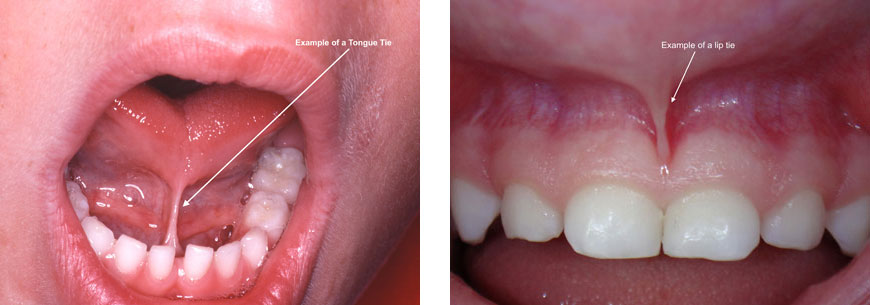Lip and tongue ties (Prominent Maxillary and Mandibular Frenae)
What is a frenum?
A frenum is a small fold of tissue that secures or restricts the motion of other soft tissue in the mouth.
In the mouth there are three main frenula that may benefit from a frenectomy procedure:
- a flap of tissue that extends from the centre of the upper lip to the upper jaw (maxillary labial frenum)
- flap of tissue that extends from lips to lower jaw (mandibular labial frenum)
- fold of tissue connecting the tongue to the floor of the mouth (mandibular lingual frenum)
Lip and tongue ties
A “lip tie” is a term describing the case where the maxillary (upper) or mandibular (lower) frenum excessively restricts the movement of the lip.
A “tongue tie” or ankyloglossia is the term describing a situation where the mandibular lingual frenum attaches to the tongue, hence overly restricting the movement of the tongue.
What are the effects of lip and/or tongue ties?
- causing the separation of the front teeth, which creates a space or gap called a diastema which increases the risk of an upset bite (malocclusion)
- speech problems that hinder a person’s fluency
- difficult feeding/sucking or children and babies due to an inability to latch and create a good seal
- increasing the risk of developing dental decay and bleeding gums due to difficulty in maintaining oral hygiene (cleaning)
- in some severe cases, a child may present swallowing, digestive and airway issues
What is a frenectomy?
A procedure where the small fold of tissues cut and released to allow for a better range of motion.
We complete the frenectomy using a surgical and/or a soft tissue laser procedure.
Laser frenectomy – How does it work?
- a soft tissue laser does not cut, it is more of a vaporisation of tissue that occurs with light energy
- very little discomfort during and after laser procedure
- lasers are minimally invasive in most instances and there is minimal bleeding hence eliminating the need for stitches
- lasers sterilise at touch therefore lowering the risk of infection
- a laser stimulates bio-generation and helps promote soft tissue healing which is usually quick
Why would a frenectomy be completed?
- newborns or infants who are having trouble latching and feeding following an assessment by a lactation consultant, paediatrician or ENT specialist
- young children with speech issues following assessment with a speech therapist
- children with dental decay or trauma exacerbated by a prominent frenulum
- children who have a large gap in between their front two teeth or have orthodontic issues
- as requested by an orthodontist or in conjunction with orthodontic treatment
When is the best time to do a frenectomy?
Ideal timing for the procedure depends on the adverse effects of the attached tissue and the likely benefits of treatment.
Such cases include:
- if your baby or child is having issues with feeding, decay or speech, having the procedure completed as soon as possible would be advised
- if the procedure is due to malocclusion and a “gap”, the ideal time for a maxillary frenectomy is prior to exfoliation of the primary incisors and eruption of the permanent successors. This is usually around 5-6 years of age
Despite performing a frenectomy, some children may require orthodontic treatment when they are older to correct malocclusion or close gaps. We would continuously monitor this as your child grows.
Furthermore, as your child gets older, they may require a follow up frenectomy. Usually, this is performed in conjunction with orthodontic treatment due to growth and development (puberty) as the frenulum may re-attach.
Depending on the age and cooperation of your child, this procedure is performed in the dental chair using relative analgesia/local anaesthesia or in hospital under general anaesthesia.

Figure showing tongue and lip ties

